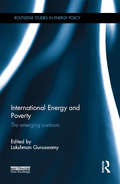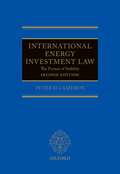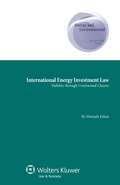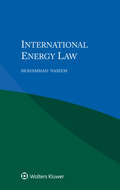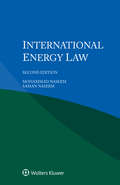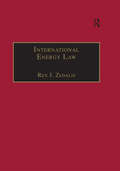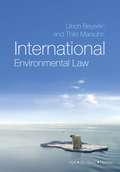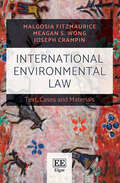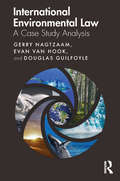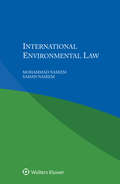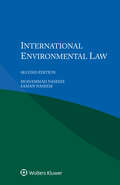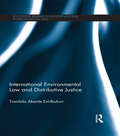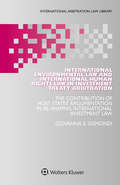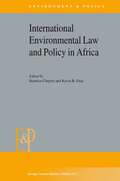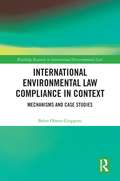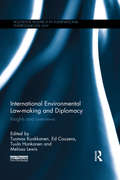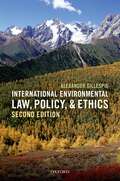- Table View
- List View
International Energy and Poverty: The emerging contours (Routledge Studies in Energy Policy)
by Lakshman GuruswamyAround 2.8 billion people globally, also known as the "Other Third" or "energy poor", have little or no access to beneficial energy that meets their needs for cooking, heating, water, sanitation, illumination, transportation, or basic mechanical power. This book uniquely integrates the hitherto segmented and fragmented approaches to the challenge of access to energy. It provides theoretical, philosophical and practical analysis of energy for the low energy (non-hydrocarbon based) Other Third of the world, and how the unmet needs of the energy poor might be satisfied. It comprehensively addresses the range of issues relating to energy justice and energy access for all, including affordable - sustainable energy technologies (ASETs). The book breaks new ground by crafting a unified and cohesive framework for analysis and action that explains the factual and socio-political phenomenon of the energy poor, and demonstrates why clean energy is a primary determinant of their human progress. This is a must-read for all scholars, students, professionals and policy makers working on energy policy, poverty, and sustainable energy technologies.
International Energy Investment Law: The Pursuit of Stability
by Peter CameronFollowing the success of International Energy Investment Law: The Pursuit of Stability, this updated and expanded second edition re-examines and assesses the variety of contract- and treaty-based instruments in commercial and international law that strive to protect the respective interests of investors and states in the international energy industry. Over past years an unprecedented growth of international investment law in the form of BITs, MITs, other treaty-based instruments, and domestic legislation has fundamentally altered the legal framework and offers extensive scope for international arbitration in the event of disputes. A wave of unilateral state action has tested the system in a number of high-value commercial disputes, most evidently in Latin American, Eastern Europe, and sub-Saharan Africa; protection for investors is being tested as arbitrators develop new notions of legitimate expectation and give content to fair and equitable treatment, while mapping out more precisely the duties which investors owe to host states. This book critically examines the interaction between contract and treaty forms of stability in the new multi-tier setting, including highly detailed regional case studies of Latin America, Eastern Europe, and (new to this edition) Africa. Central to the new edition is its expanded content on renewable energy, including claims under the Energy Charter Treaty, and energy-related minerals now playing a key role in the transition to a low carbon economy; the updated chapter on environmental issues also addresses decommissioning and low carbon/climate change issues. The book also considers emerging issues in unconventional oil and gas, issues arising from energy network operation including transit, and damages issues arising in energy cases. Particular attention is paid to the practical impact of these issues and the enforcement of awards by arbitration tribunals and bodies such as the ICSID, the ICC, and the LCIA. In its concluding section, the book looks forward to new challenges arising from climate change, human rights, and environmental issues.
International Energy Investment Law: The Pursuit of Stability
by Peter CameronFollowing the success of International Energy Investment Law: The Pursuit of Stability, this updated and expanded second edition re-examines and assesses the variety of contract- and treaty-based instruments in commercial and international law that strive to protect the respective interests of investors and states in the international energy industry. Over past years an unprecedented growth of international investment law in the form of BITs, MITs, other treaty-based instruments, and domestic legislation has fundamentally altered the legal framework and offers extensive scope for international arbitration in the event of disputes. A wave of unilateral state action has tested the system in a number of high-value commercial disputes, most evidently in Latin American, Eastern Europe, and sub-Saharan Africa; protection for investors is being tested as arbitrators develop new notions of legitimate expectation and give content to fair and equitable treatment, while mapping out more precisely the duties which investors owe to host states. This book critically examines the interaction between contract and treaty forms of stability in the new multi-tier setting, including highly detailed regional case studies of Latin America, Eastern Europe, and (new to this edition) Africa. Central to the new edition is its expanded content on renewable energy, including claims under the Energy Charter Treaty, and energy-related minerals now playing a key role in the transition to a low carbon economy; the updated chapter on environmental issues also addresses decommissioning and low carbon/climate change issues. The book also considers emerging issues in unconventional oil and gas, issues arising from energy network operation including transit, and damages issues arising in energy cases. Particular attention is paid to the practical impact of these issues and the enforcement of awards by arbitration tribunals and bodies such as the ICSID, the ICC, and the LCIA. In its concluding section, the book looks forward to new challenges arising from climate change, human rights, and environmental issues.
International Energy Investment Law: Stability through Contractual Clauses
by Mustafa ErkanContemporary legal practice has developed powerful contractual mechanisms to mitigate the political risks attendant on energy projects. However, until now most of what we know about the contractual management of these risks has been based on theoretical literature and the facts of cases rather than careful empirical study. This one-of-a-kind book breaks new ground. The author presents the results of a questionnaire-based survey circulated to the main players in the petroleum sector, revealing actual existing contractual risk management techniques and showing a true picture of the political risk situation in the petroleum sector. Going far beyond an analysis of the literature, the research includes in-depth interviews with specialist lawyers and representatives of companies who have not only a theoretical knowledge but practical experience with the problems of host government interventions, as well as with international petroleum negotiators, members of international organizations in the petroleum business, and dispute settlement bodies.
International Energy Investment Law: Stability through Contractual Clauses
by Mustafa ErkanContemporary legal practice has developed powerful contractual mechanisms to mitigate the political risks attendant on energy projects. However, until now most of what we know about the contractual management of these risks has been based on theoretical literature and the facts of cases rather than careful empirical study. This one-of-a-kind book breaks new ground. The author presents the results of a questionnaire-based survey circulated to the main players in the petroleum sector, revealing actual existing contractual risk management techniques and showing a true picture of the political risk situation in the petroleum sector. Going far beyond an analysis of the literature, the research includes in-depth interviews with specialist lawyers and representatives of companies who have not only a theoretical knowledge but practical experience with the problems of host government interventions, as well as with international petroleum negotiators, members of international organizations in the petroleum business, and dispute settlement bodies.
International Energy Law
by Mohammad NaseemThis book provides a systematic approach to legislation and legal practice concerning energy resources and production in International Energy Law. The book describes the broad international energy set up, administrative organization, regulatory framework, and relevant case law pertaining to the development, application, and use of such forms of energy as electricity, gas, petroleum, and coal, with attention as needed to the pervasive legal effects of competition law, environmental law and tax law. A general introduction covers the geography of energy resources, sources and basic principles of energy law, and the relevant governmental institutions. Then follows a detailed description of specific legislation and regulation affecting such factors as documentation, undertakings, facilities, storage, pricing, procurement and sales, transportation, transmission, distribution, and supply of each form of energy. Case law, intergovernmental cooperation agreements, and interactions with environmental, tax, and competition law are explained. Its succinct yet scholarly nature, as well as the practical quality of the information it provides, make this book a valuable resource for energy sector policymakers, negotiators, investors and energy firm counsel handling cases affecting International Energy Law. It will also be welcomed by researchers and academics for its contribution to the study of the complex field of energy law that has peculiar characteristics because of associated risks and rewards.
International Energy Law
by Mohammad Naseem Saman NaseemDerived from the renowned multi-volume International Encyclopaedia of Laws, this book provides a systematic approach to legislation and legal practice concerning energy resources and production in International Energy Law. The book describes the administrative organization, regulatory framework, and relevant case law pertaining to the development, application, and use of such forms of energy as electricity, gas, petroleum, and coal, with attention as needed to the pervasive legal effects of competition law, environmental law, and tax law. A general introduction covers the geography of energy resources, sources and basic principles of energy law, and the relevant governmental institutions. Then follows a detailed description of specific legislation and regulation affecting such factors as documentation, undertakings, facilities, storage, pricing, procurement and sales, transportation, transmission, distribution, and supply of each form of energy. Case law, intergovernmental cooperation agreements, and interactions with environmental, tax, and competition law are explained. Its succinct yet scholarly nature, as well as the practical quality of the information it provides, make this book a valuable resource for energy sector policymakers and energy firm counsel handling cases affecting International Energy Law. It will also be welcomed by researchers and academics for its contribution to the study of a complex field that today stands at the foreground of comparative law.
International Energy Law: Rules Governing Future Exploration, Exploitation and Use of Renewable Resources
by Rex J. ZedalisThe international legal rules affecting renewable alternative energy resources are amongst the most important legal and environmental concerns of the near future. As traditional energy sources are depleted, new technologies are being developed to harness the potentials of wave, current and tidal energy, coastal wind power, offshore geothermal, polar energy resources and space-based solar collection. This book is the first comprehensive analysis of the legal rules governing the alternative energy resource potential of all international common areas - the high seas, the polar zones (especially Antarctica) and outer space. In a detailed, but precisely analyzed text, the book also reviews the international environmental rules affecting exploration, exploitation and use of internationally situated energy resources, alongside resources located offshore under national jurisdictions. This is accompanied by a critical look at the connection between efforts to control greenhouse gases and the growing interest in non-polluting alternatives found in the international "commons . The result is a work of unprecedented value for environmental and international law academics and practitioners, as well as those interested in environmental resource economics and politics.
International Energy Law: Rules Governing Future Exploration, Exploitation and Use of Renewable Resources
by Rex J. ZedalisThe international legal rules affecting renewable alternative energy resources are amongst the most important legal and environmental concerns of the near future. As traditional energy sources are depleted, new technologies are being developed to harness the potentials of wave, current and tidal energy, coastal wind power, offshore geothermal, polar energy resources and space-based solar collection. This book is the first comprehensive analysis of the legal rules governing the alternative energy resource potential of all international common areas - the high seas, the polar zones (especially Antarctica) and outer space. In a detailed, but precisely analyzed text, the book also reviews the international environmental rules affecting exploration, exploitation and use of internationally situated energy resources, alongside resources located offshore under national jurisdictions. This is accompanied by a critical look at the connection between efforts to control greenhouse gases and the growing interest in non-polluting alternatives found in the international "commons . The result is a work of unprecedented value for environmental and international law academics and practitioners, as well as those interested in environmental resource economics and politics.
International Environmental Law
by Ulrich Beyerlin Thilo MarauhnInternational Environmental Law is a new textbook written for students, practitioners, and anyone interested in the subject. The overall aim of the book is to provide a fresh understanding of international environmental law as a whole, seen in the light of climate change, biodiversity loss, and the other serious environmental challenges facing the world. The book has also been kept deliberately manageable in size by careful selection of topics and by adopting a cross-cutting synthesis of regulatory interaction in the field. This enables the reader to place international environmental law in the broader context of public international law in general, revealing at the same time that international environmental law is experimental ground for developing new legal approaches towards global governance. To this end, the authors have combined theory and practice.Apart from discussing concepts, rule-making and compliance, the book looks at options for improved coordination, harmonisation and even integration of existing multilateral environmental agreements, analysing how conflicts between various environmental regimes can be avoided or, at least, adequately managed. The authors argue that an appropriate management of international environmental relations must address the North-South divide, which continues to be a major obstacle to global environmental cooperation. Furthermore, the authors emphasise the growing human rights dimension of international environmental law.This book is an ideal 'door opener' for the further study of international environmental law. Focusing on 'international environmental governance' in a comprehensive way, it serves to explain that each institution, each actor, and each instrument is part of a multi-dimensional process in international environmental law and relations.
International Environmental Law: Text, Cases and Materials
by Malgosia Fitzmaurice Meagan S. Wong Joseph CrampinThis textbook provides a compelling and structured introduction to international environmental law in the Text, Cases and Materials genre.The book uses extracts from a judiciously selected range of legal instruments and case law relevant to the protection and regulation of the environment in international law, alongside commentary from the author team and questions for class discussion, to facilitate student understanding and encourage engagement in the topic.Divided into four main parts, it examines the main principles of international environmental law, the key areas of substantive environmental regulation, the implementation of environmental law and the relations between environmental law and other areas of international law. Key Features: Provides concise introductions to each topic of environmental lawDiscussion questions and further reading sections guide students in applying their understandingFamiliarises students with the key legal materials, treaties and case law relating to international environmental lawCovers a wide variety of topics, including sustainable development, protection of the marine environment, atmospheric protection and responsibility and liability for environmental damage By introducing and highlighting the most important instruments and cases of international environmental law, this textbook seeks to provide environmental law students and non-specialists with a rich and full understanding of the topic.
International Environmental Law: A Case Study Analysis
by Gerry Nagtzaam Evan van Hook Douglas GuilfoyleThis book seeks to better understand how International Environmental Law regimes evolve. The authors address throughout the major environmental, economic, and political tensions that have both shaped and constrained the evolution of international environmental policy within regimes, and its expression in international legal rule and norm development. Readers will gain an increased understanding of the growing role played by non-state actors in global environmental governance, including environmental non-government organisations, scientists, the United Nations, and corporations. The authors also look ahead to the future of International Environmental Law, evaluating key challenges and decisions that the discipline will face. The text is clear, concise, and accessible. It is ideally suited to students and professionals interested in International Environmental Law, and individuals who are intrigued by this dynamic area of law.
International Environmental Law: A Case Study Analysis
by Gerry Nagtzaam Evan van Hook Douglas GuilfoyleThis book seeks to better understand how International Environmental Law regimes evolve. The authors address throughout the major environmental, economic, and political tensions that have both shaped and constrained the evolution of international environmental policy within regimes, and its expression in international legal rule and norm development. Readers will gain an increased understanding of the growing role played by non-state actors in global environmental governance, including environmental non-government organisations, scientists, the United Nations, and corporations. The authors also look ahead to the future of International Environmental Law, evaluating key challenges and decisions that the discipline will face. The text is clear, concise, and accessible. It is ideally suited to students and professionals interested in International Environmental Law, and individuals who are intrigued by this dynamic area of law.
International Environmental Law
by Mohammad Naseem Saman NaseemDerived from the renowned multi-volume International Encyclopaedia of Laws, this book provides ready access to treaties,conventions, legislation and practice concerning the International Environmental Law. A general introduction covers geographic considerations, political, social and cultural aspects of environmental study, the history, sources and principles of environmental law, environmental legislation, carbon credits and the role of public authorities. The main body of the book deals first with laws aimed directly at protecting the environment from pollution in specific areas such as air, water, waste, soil, noise, and radiation. Then, a section on nature and conservation management covers protection of natural and cultural resources such as monuments, landscapes, parks and reserves, wildlife, agriculture, forests, fish, subsoil, and minerals. Further treatment includes the application of zoning and land-use planning, rules on liability, and administrative and judicial remedies to environmental issues and disputes. There is also an analysis of the impact of international and regional legislation and treaties on environmental regulation. Its succinct yet scholarly nature, as well as the practical quality of the information it provides, make this book a valuable resource for lawyers handling cases dealing with and affecting international environment. Academics and researchers, as well as business investors,corporate houses and international organizations in the field, will welcome this very useful guide, and will appreciate its value in the study of comparative international environmental law and policy.
International Environmental Law
by Mohammad Naseem Saman NaseemDerived from the renowned multi-volume International Encyclopaedia of Laws, this book provides ready access to treaties, conventions, legislation and practice concerning the International Environmental Law. A general introduction covers geographic considerations, political, social and cultural aspects of environmental study, the history, sources and principles of environmental law, environmental legislation, carbon credits and the role of public authorities. The main body of the book deals first with laws aimed directly at protecting the environment from pollution in specific areas such as air, water, waste, soil, noise, and radiation. Then, a section on nature and conservation management covers protection of natural and cultural resources such as monuments, landscapes, parks and reserves, wildlife, agriculture, forests, fish, subsoil, and minerals. Further treatment includes the application of zoning and land-use planning, rules on liability, and administrative and judicial remedies to environmental issues and disputes. There is also an analysis of the impact of international and regional legislation and treaties on environmental regulation. Its succinct yet scholarly nature, as well as the practical quality of the information it provides, make this book a valuable resource for lawyers handling cases dealing with and affecting international environment. Academics and researchers, as well as business investors, corporate houses and international organizations in the field, will welcome this very useful guide, and will appreciate its value in the study of comparative international environmental law and policy.
International Environmental Law and Distributive Justice: The Equitable Distribution of CDM Projects under the Kyoto Protocol (Routledge Research in International Environmental Law)
by Tomilola Akanle Eni-IbukunThe Clean Development Mechanism (CDM) is widely regarded as one of the Kyoto Protocol’s best creations and as an essential part of the international climate change regime. The CDM has been constantly evolving to ensure that it fulfils its objectives of mitigating climate change and contributing to sustainable development in developing countries. The over 6,000 registered projects under the CDM are estimated to have generated almost US$200 billion of investment in developing countries and are expected to achieve GHG emission reductions of about 6.8 billion tonnes. Nevertheless, the CDM is not perfect, and one of its main problems is the inequitable geographic distribution of projects among developing countries. Understandably, this is a problem that countries are very keen to address, and since 2001, even before the first project was registered, countries have been highlighting the need to ensure that projects are equitably distributed among participating countries. This book looks at distributive justice under the CDM regime and focuses on the issue of equity in the geographic distribution of CDM projects among developing countries. The book investigates relevant aspects of international law to identify the legal characteristics of equitable distribution or distributive justice, in order to establish what equitable distribution in the CDM should look like. Based on these investigations, Tomilola Akanle Eni-Ibukun breaks new ground in defining equitable distribution under the CDM and exploring how key obstructions to the equitable distribution of projects may be overcome. The book will be of particular interest to academics and policymakers of climate change and the CDM within international law.
International Environmental Law and Distributive Justice: The Equitable Distribution of CDM Projects under the Kyoto Protocol (Routledge Research in International Environmental Law)
by Tomilola Akanle Eni-IbukunThe Clean Development Mechanism (CDM) is widely regarded as one of the Kyoto Protocol’s best creations and as an essential part of the international climate change regime. The CDM has been constantly evolving to ensure that it fulfils its objectives of mitigating climate change and contributing to sustainable development in developing countries. The over 6,000 registered projects under the CDM are estimated to have generated almost US$200 billion of investment in developing countries and are expected to achieve GHG emission reductions of about 6.8 billion tonnes. Nevertheless, the CDM is not perfect, and one of its main problems is the inequitable geographic distribution of projects among developing countries. Understandably, this is a problem that countries are very keen to address, and since 2001, even before the first project was registered, countries have been highlighting the need to ensure that projects are equitably distributed among participating countries. This book looks at distributive justice under the CDM regime and focuses on the issue of equity in the geographic distribution of CDM projects among developing countries. The book investigates relevant aspects of international law to identify the legal characteristics of equitable distribution or distributive justice, in order to establish what equitable distribution in the CDM should look like. Based on these investigations, Tomilola Akanle Eni-Ibukun breaks new ground in defining equitable distribution under the CDM and exploring how key obstructions to the equitable distribution of projects may be overcome. The book will be of particular interest to academics and policymakers of climate change and the CDM within international law.
International Environmental Law and International Human Rights Law in Investment Treaty Arbitration: The Contribution of Host States' Argumentation in Re-Shaping International Investment Law (International Arbitration Law Library #68)
by Giovanna E. GismondiPolicies aimed at the expansion of transnational capital are sometimes implemented at the expense of growing social inequality and popular frustration in host countries. This timely and deeply researched volume identifies – and offers new insights into – the growing use of and reliance upon international environmental and human rights law in the arbitration of investor–State disputes. It presents a comprehensive and pragmatic approach to the most effective way to connect international investment law to the protection of human rights and the environment. Based on an analysis of 30 arbitral awards, this book demonstrates how recent investment treaty arbitration – and in particular respondent States’ argumentation in arbitral proceedings – highlights the human rights and environmental considerations connected with such factors as the following: the fair and equitable treatment (FET) clause; jurisdictional obstacles; treaty conflict; role of amici curiae; damages; tribunal’s dilution of the significance of environmental and human rights law; corporate social responsibility; free, prior, and informed consent; social license to operate; and (in)applicability of the systemic approach to the interpretation of investment treaties. As investment arbitration continues to be challenged by growing demands for greater public involvement and for participation of third parties that are affected by the proceedings, this book responds to the need to reshape the investment regime into more human rights and environmentally friendly system. It will prove an invaluable resource for arbitral institutions, academics, arbitrators, arbitration counsel, and other participants in investment treaty arbitration.
International Environmental Law and Policy in Africa (Environment & Policy #36)
by B. Chaytor K. R. GrayC.O.OKIDl1 I welcome the opportunity to prepare a Foreword to the book on Environmental Policy and Law in Africa, edited by Kevin R. Gray and Beatrice Chaytor. It is a pleasure to do that because the book is a contribution to the cause of capacity building for development and implementation of environmental law in Africa, a goal towards which I have had an undivided focus over the last two decades. There is still some belief in and outside Africa that for developing countries in general, and Africa in particular, development and implementation of environmental law is not a priority. This belief prevails strongly in many quarters of the industrialised countries. In fact, the view is held either out of blatant ignorance or by some renegade industrialists who fail to appreciate Michael Royston's 1979 thesis that Pollution Prevention Pays.2 That group, for obvious reasons, must have their correspondent counterparts in Africa to provide hope that industries rejected as derelict in the West or inoperable due to rigorous environmental regulation, can find homes to which they can escape and dump their polluting industries.
International Environmental Law Compliance in Context: Mechanisms and Case Studies (Routledge Research in International Environmental Law)
by Belen Olmos GiupponiThis book explores how compliance with international environmental law has changed over time, offering a critical analysis of its current shifting patterns. Beginning with an overview of compliance with international environmental law, the book goes on to explore in detail: compliance in the different legal regimes instituted by Multilateral Environmental Agreements (MEAs), the addition of new subjects of international law, the legal relations between developed and developing countries, and the emergence of new compliance mechanisms in global environmental law. The analysis takes two key developments into consideration: the evolution in forms of compliance and non-state involvement in compliance with international environmental law. In the final section, three case studies are provided to demonstrate how these changes have occurred in selected areas: climate change, biodiversity and water resources. Throughout the book, topics are illustrated with extracts from specific international environmental law jurisprudence and relevant international environmental law instruments. In doing so, the book offers a comprehensive analysis of compliance with international environmental law, providing original insights and following a clear and systematic structure supported by reference to the sources. This book will be of interest to professionals, academics and students working in the field of compliance with international environmental law.
International Environmental Law Compliance in Context: Mechanisms and Case Studies (Routledge Research in International Environmental Law)
by Belen Olmos GiupponiThis book explores how compliance with international environmental law has changed over time, offering a critical analysis of its current shifting patterns. Beginning with an overview of compliance with international environmental law, the book goes on to explore in detail: compliance in the different legal regimes instituted by Multilateral Environmental Agreements (MEAs), the addition of new subjects of international law, the legal relations between developed and developing countries, and the emergence of new compliance mechanisms in global environmental law. The analysis takes two key developments into consideration: the evolution in forms of compliance and non-state involvement in compliance with international environmental law. In the final section, three case studies are provided to demonstrate how these changes have occurred in selected areas: climate change, biodiversity and water resources. Throughout the book, topics are illustrated with extracts from specific international environmental law jurisprudence and relevant international environmental law instruments. In doing so, the book offers a comprehensive analysis of compliance with international environmental law, providing original insights and following a clear and systematic structure supported by reference to the sources. This book will be of interest to professionals, academics and students working in the field of compliance with international environmental law.
International Environmental Law-making and Diplomacy: Insights and Overviews (Routledge Research in International Environmental Law)
by Tuomas Kuokkanen Ed Couzens Tuula Honkonen Melissa LewisBringing together contributions from diplomats, UN agency officials, lawyers and academics, this book provides insight into the evolution of international environmental law, diplomacy and negotiating techniques. Based on first-hand experiences and extensive research, the chapters offer a blend of practice and theory, history and analysis, presenting a range of historical episodes and nuances and drawing lessons for future improvements to the processes of law-making and diplomacy. The book represents a synthesis of the most important messages to emerge from the annual course on Multilateral Environmental Agreements, delivered to diplomats and negotiators from around the world for the last decade by the University of Eastern Finland and the United Nations Environment Programme. The book will be of interest as a guide for negotiators and as a supplementary textbook and a reference volume for a wide range of students of law and environmental issues.
International Environmental Law-making and Diplomacy: Insights and Overviews (Routledge Research in International Environmental Law)
by Tuomas Kuokkanen Ed Couzens Tuula Honkonen Melissa LewisBringing together contributions from diplomats, UN agency officials, lawyers and academics, this book provides insight into the evolution of international environmental law, diplomacy and negotiating techniques. Based on first-hand experiences and extensive research, the chapters offer a blend of practice and theory, history and analysis, presenting a range of historical episodes and nuances and drawing lessons for future improvements to the processes of law-making and diplomacy. The book represents a synthesis of the most important messages to emerge from the annual course on Multilateral Environmental Agreements, delivered to diplomats and negotiators from around the world for the last decade by the University of Eastern Finland and the United Nations Environment Programme. The book will be of interest as a guide for negotiators and as a supplementary textbook and a reference volume for a wide range of students of law and environmental issues.
International Environmental Law, Policy, and Ethics
by Alexander GillespieThis second edition of International Environmental Law, Policy, and Ethics revises and expands this groundbreaking study into the question of why the environment is protected in the international arena. This question is rarely asked because it is assumed that each member of the international community wants to achieve the same ends. However, in his innovative study of international environmental ethics, Alexander Gillespie explodes this myth. He shows how nations, like individuals, create environmental laws and policies which are continually inviting failure, as such laws can often be riddled with inconsistencies, and be ultimately contradictory in purpose. Specifically, he seeks a nexus between the reasons why nations protect the environment, how these reasons are reflected in law and policy, and what complications arise from these choices. This book takes account of the numerous developments in international environmental law and policy that have taken place the publication of the first edition, most notably at the 2002 World Summit on Sustainable Development and the 2012 'Rio + 20' United Nations Conference on Sustainable Development. Furthermore, it addresses recent debates on the economic value of nature, and the problems of the illegal trade in species and toxic waste. The cultural context has also been considerably advanced in the areas of both intangible and tangible heritage, with increasing attention being given to conservation, wildlife management, and the notion of protected areas. The book investigates the ways in which progress has been made regarding humane trapping and killing of animals, and how, in contrast, the Great Apes initiative, and similar work with whales, have failed. Finally, the book addresses the fact that while the notion of ecosystem management has been embraced by a number of environmental regimes, it has thus far failed as an international philosophy.
International Environmental Law, Policy, and Ethics
by Alexander GillespieThis second edition of International Environmental Law, Policy, and Ethics revises and expands this groundbreaking study into the question of why the environment is protected in the international arena. This question is rarely asked because it is assumed that each member of the international community wants to achieve the same ends. However, in his innovative study of international environmental ethics, Alexander Gillespie explodes this myth. He shows how nations, like individuals, create environmental laws and policies which are continually inviting failure, as such laws can often be riddled with inconsistencies, and be ultimately contradictory in purpose. Specifically, he seeks a nexus between the reasons why nations protect the environment, how these reasons are reflected in law and policy, and what complications arise from these choices. This book takes account of the numerous developments in international environmental law and policy that have taken place the publication of the first edition, most notably at the 2002 World Summit on Sustainable Development and the 2012 'Rio + 20' United Nations Conference on Sustainable Development. Furthermore, it addresses recent debates on the economic value of nature, and the problems of the illegal trade in species and toxic waste. The cultural context has also been considerably advanced in the areas of both intangible and tangible heritage, with increasing attention being given to conservation, wildlife management, and the notion of protected areas. The book investigates the ways in which progress has been made regarding humane trapping and killing of animals, and how, in contrast, the Great Apes initiative, and similar work with whales, have failed. Finally, the book addresses the fact that while the notion of ecosystem management has been embraced by a number of environmental regimes, it has thus far failed as an international philosophy.
